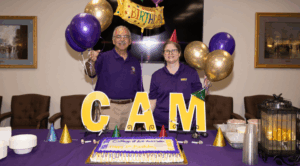HSU Hosts Tri-University Trauma Training

(ABILENE, Texas) Hardin-Simmons University hosted a Trauma-Informed Care (TIC) training for about 60 professionals from HSU, ACU, and McMurry on Aug. 24. Police officers, student life coordinators, and counselors learned from specialists from Resolution Solutions during the three-hour course.

Nikki Rhodes
“Trauma-Informed Care is so important for professionals engaging with students on a day-to-day basis,” said Nikki Rhodes, HSU director of counseling services. “As reporting rates increase, our campuses are realizing just how many students are impacted by trauma, either present or historical—and this offers us a specific tool to care for our students holistically.”
Tony Barker gave practical advice to help professionals communicate with victims who have experienced trauma. He outlined the four tools of effective communication: listening, communicating, perspective, and creativity. He also suggested using a non-judgmental, attentive posture and stimulating different areas of the brain by taking the victim on a walk, giving them a glass of water, or even applying lotion to activate different sensory responses.
Barker encouraged all who work with trauma victims to create a trusting relationship, where they know they are being heard. Asking questions like, “Why didn’t you run away or scream?” are often translated by the victim as judgment statements that lessen the victim’s sense of security and make them less likely to trust authorities. Barker informed his listeners that 50% of women being raped experience tonic immobility, a symptom of the fight or flight response where victims experience temporary paralysis.
This response suggests that fight or flight should rather be fight, flight, or freeze, as trauma victims undergo one of these three phenomena. Higher-level critical thinking and decision making are related to the executive function of the brain’s prefrontal cortex. When traumatic stressors are introduced, the amygdala takes over, which allows for simple decisions to be made quickly. When the amygdala “hijacks” the brain’s functions, a victim will often feel stuck in the moment or will experience difficulty trying to explain things in a reasonable or complex way.
Patty Wenetschlaeger shared about the importance of self-care for anyone who deals with people who have experienced trauma. She explained that physical, psychological, moral, and interpersonal symptoms of trauma victims can all be experienced through secondary or vicarious trauma as well. She emphasized that symptoms of secondary trauma directly mirror those of primary trauma, meaning that caregivers and first responders experience the same physical and mental symptoms as the abuse victims they are near.
She poses the important questions, “how do we shift our brain? How do we stop thinking about the things we think about all day?” Those in stressful positions often carry their work stressors home with them, causing relational, physical, and mental problems outside of the workplace. Therefore, it is important, Wenetschlaeger said, for those in high stress positions to take time for daily self-care.
Wenetschlaeger gave easy self-care tips that everyone can do throughout their day: taking deep breaths, going for a walk, using a stress ball, and putting cell phones away at least one meal per day. She also encouraged the audience to find what self-care habits work best for them. Listening to music, baking, yoga, meditation, and other relaxing activities help the brain to recover. She advocated for accountability partners and “finding your tribe,” as self-care includes talking through trauma with others who understand.


